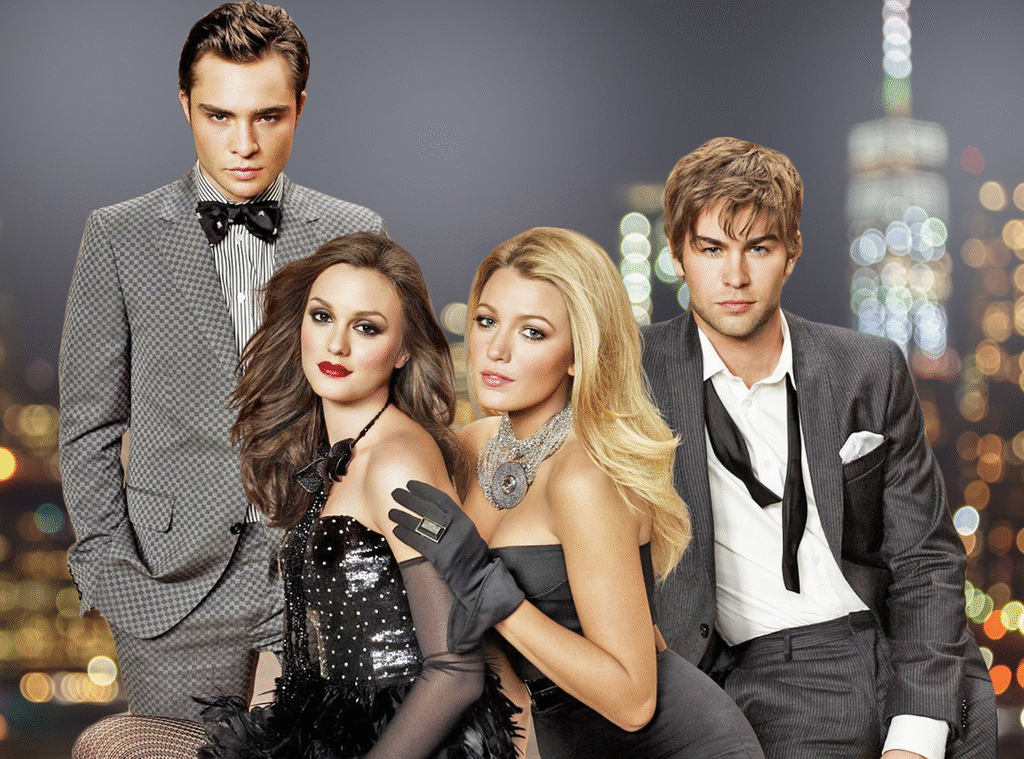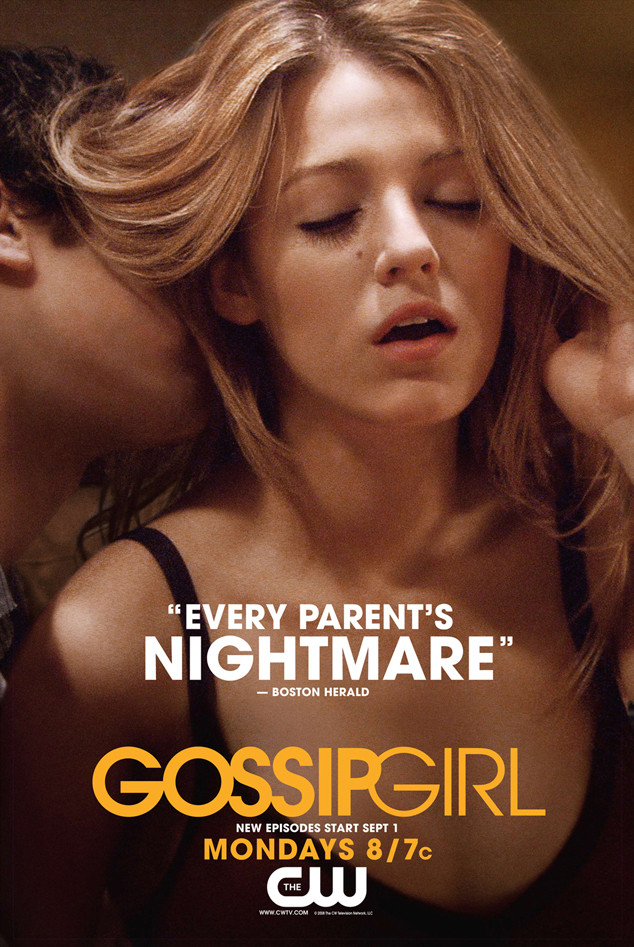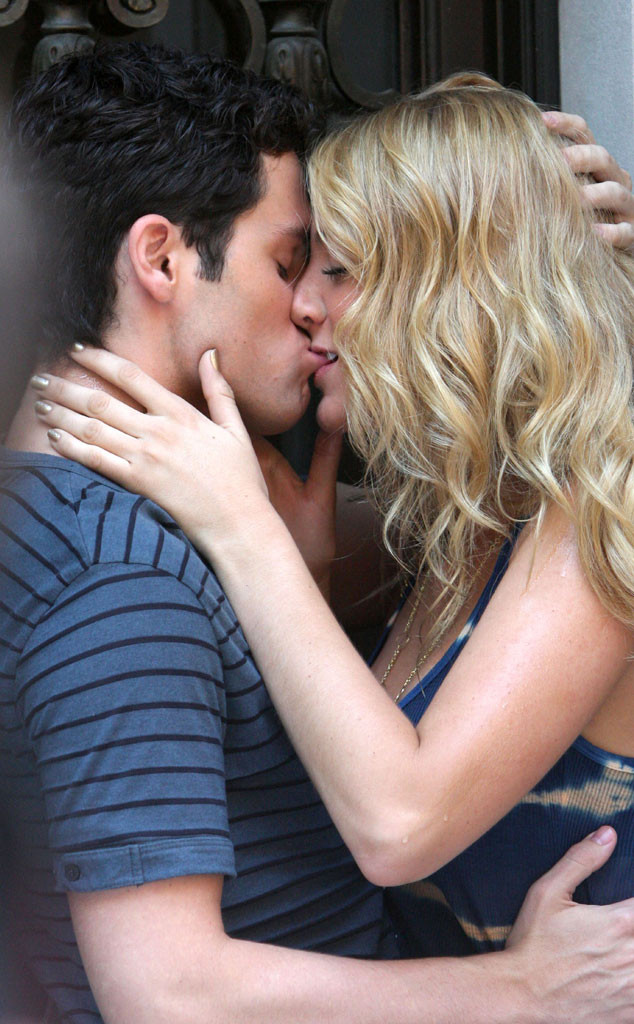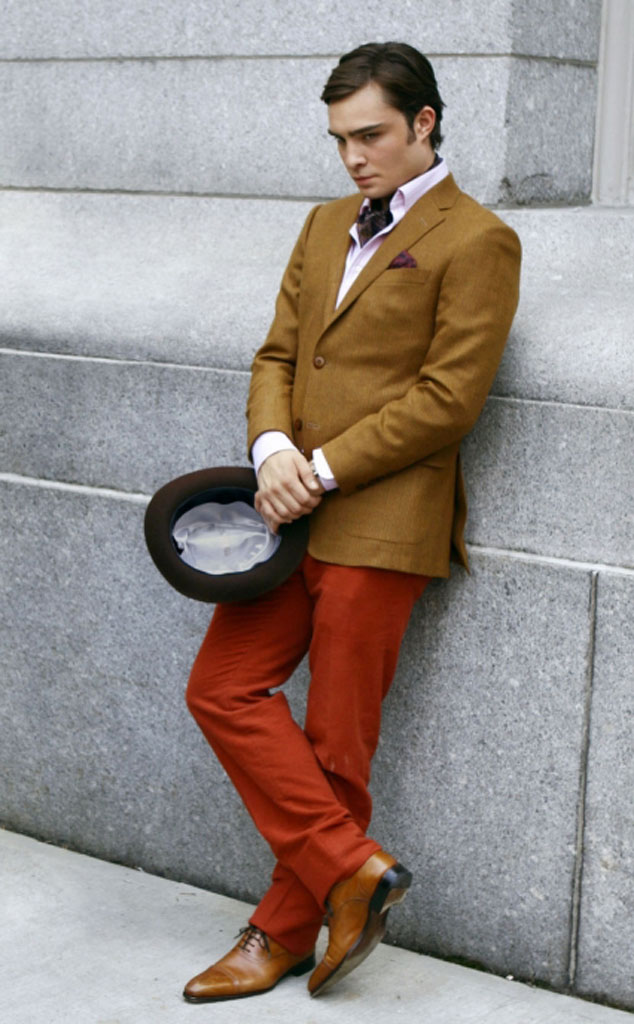Spotted: The internet having a collective meltdown over the news that Gossip Girl is coming back, ready to follow a new group of elite rich kids on the UES.
E! News has confirmed HBO Max, the new streaming destination from WarnerMedia (where Friends will now live after leaving Netflix) has given a 10-episode order to a reboot of the iconic CW series that launched the careers of Blake Lively, Penn Badgley and Leighton Meester, and became a pop culture phenomenon, at one point being dubbed—somewhat ironically—the “Greatest Show of Our Time” by New York Magazine.
But even on TV, you can’t stay in high school forever, so the new take on Gossip Girl—which comes from the original executive producers Josh Schwartz and Stephanie Savage, and one-time showrunner Josh Safran—will pick up eight years after the OG ended, with a new generation of prep school teens finding themselves under the thumb of Gossip Girl when the site is mysteriously restored. She knew you missed her, too.
“Phones get updated, but the inner life of teenagers, and the things that they struggle with, are pretty timeless, regardless of what device they’re on,” Schwartz once said to Vanity Fair.
Like the technology that will be used by its characters, Gossip Girl, which ended its initial run in 2012 but remains as popular as ever thanks to Netflix, will be majorly revamped for HBO Max, as it promises to “address just how much social media—and the landscape of New York itself—has changed in the intervening years.”
It’ll also have to contend with how much the TV landscape it once helped define has evolved since it signed off with its final XOXO.

The CW; Melissa Herwitt/E! Illustration
When Gossip Girl aired it defined an an era of television for a certain generation—while it almost always had an 8 p.m. time-slot, it pushed the envelope on what could be done on a network drama. Blair losing her virginity in the back of a limo with her BF’s BFF? Our current Bachelorette just bragged about having sex in a windmill. Twice. Dan having an affair with his high school English teacher? Three years later, that was Pretty Little Liars‘ main love story. A threesome with Disney darling Hilary Duff? HBO’s Euphoria would likely find that adorable but at the time it was a big effin’ deal.
But back in 2007, GG was leading the way for more OMG moments on TV, with The CW fully supporting them as the new network, which came to fruition after The WB and UPN merged, was desperate for their first hit series, one that could define the younger-skewering network.
Based on the bestselling book series of the same name by Cecily von Ziegesar, Schwartz and Savage knew as soon as they read the first book that this was the TV show they wanted to make after just wrapping up The O.C., the other generation-defining teen drama the duo are responsible for.
After spending four seasons exploring the inner lives of the rich and privileged in the mansions of Orange County, they were ready to dive deep and expose the skeletons in the high-end closets in Manhattan’s penthouses.
Armed with a hot young cast—lead by Lively and Meester as the polar opposite BFFs Serena Van der Woodsen, the sunny and stunning blonde, and Blair Waldorf, the waifish and Audrey Hepburn-esque brunette—premiered on September 19, 2007. Reviews were solid. Ratings were OK, but not great, with 3.5 million viewers tuning in. The online response and fervor for Gossip Girl, however, was there from the start.
It might be hard to remember, but at that time, networks were still trying to figure out how to factor in and profit off of a show’s online popularity and DVR numbers, with streaming services not even a consideration as fans had to sometimes wait five days for an episode to be available online.
“It was incredibly frustrating. Nielsen doesn’t have a great grasp on measuring younger viewers. You couldn’t go anywhere in the country without finding people obsessed with the show” Dawn Ostroff, who was the president of The CW at the time, told Vanity Fair. “Where Gossip Girl ranked No. 100 on the Nielsen list, it was No. 13 when you looked at the power-content ratings — a combination of Nielsen ratings, traffic online and buzz.”
But what really helped Gossip Girl transition in its first season from dirty little secret to the unabashed obsession everyone you knew was talking about was ironically something that hurt so many other shows: the 2008 writer’s strike, which caused an unplanned break in production and brought the episode count to just 18 episodes.
“The CW, because they couldn’t just run repeats or game shows, [Gossip Girl is] all they had,” Schwartz told Vanity Fair. “They kept re-running the show during the strike so more and more people were watching.”
In that time, audiences found the show. And so did the Parents Television Council and other organizations and publications that criticized its “inappropriate” content and messages it was sending its young audience.
The PTC called the “mind-blowingly inappropriate,” while The San Diego Union-Tribune advised its readers that GG was “very bad for you,” like sugar or processed foods.
In a stroke of marketing genius, the network decided to use this to its advantage, launching their now iconic OMFG campaign for the show’s return in spring 2008 following the end of the writer’s strike.
Billboards of Serena’s “O” face and Chuck and Blair’s limo rendezvous were placed all over the country, emblazoned with “OMG” or “OMFG.” And those negative reviews? Proudly displayed on the posters.
“As controversial as it may have been, the campaign set the tone for the network and the brand,” Ostroff said.

The CW
The message was clear: we are the millennial guilty pleasure your parents warned you about and we don’t care. It wore its “Every parent’s nightmare” review as a badge of honor, not a scarlet letter.
“We loved it. It was using the language of the show to promote the show. It felt smart and had attitude,” Savage said of the campaign, which switched to “WTF” for its second season, cheekily saying it meant “Watch This Fall.”
And viewers did, with Gossip Girl reaching its highest ratings ever in season two, notching 3.7 million viewers. Not huge, but it was consistently the No. 1 most-downloaded show on iTunes, and eventually became the most illegally downloaded show in China (with anywhere between 3-5 million people watching, according to China Market Research Group in 2010.)
Basically, it was the Internet’s first hit TV show, paving the way for Pretty Little Liars, Riverdale and even You, Badgley’s recent hit series that found success on Netflix after failing to make a splash on Lifetime,\ among countless others that have found success solely because of social media.
With the show’s surprise smash success, its young cast was landing countless endorsement deals and magazine covers…pre-spon-con era, mind you.
Then again, even if the OG GG debuted before the launches of Instagram and Snapchat, it doesn’t seem likely that the cast assembled by Schwartz and Savage were seeking influencer-level influence. They were ridiculously attractive. They were mysterious. They were cool. So, naturally, fans wanted to know everything about them, especially their love lives. It didn’t help that some of the on-screen romances had blossomed into IRL relationships, most notably Lively and Badgley, who dated throughout the first four seasons, but remained notoriously private.

PacificCoastNews.com
“It really does feel like we’re living the show sometimes,” Badgley told Vulture in 2008. “The psychology of celebrity is such a weird and new thing. I think the last time people treated anybody else like this was demigods like in the time of ancient Greece.”
Aside from the romances, there were also bromances—with Chace Crawford (Nate Archibald) and Ed Westwick (Chuck Bass) living together in an apartment, often hitting the town together, drinking and attending concerts and occasionally shooting down dating rumors of their own—and of, course, endless rumors of fighting on-set between the two leading ladies throughout its six season run.
Here’s a sample blind item from the height of GG’s fame, courtesy of the New York Daily News: “Which rival young actresses on the same hit show are forced to pose together at PR events, even though they hate each other? One resents the other for having knocked her off her ‘star of the show’ pedestal.”
Rampant speculation be damned, Meester and Lively always shot down rumors of a rift.
“We’re very close. We’re friends. I can’t even remember a reason why people would say we’re not,” Meester, who is now married to The O.C.‘s Adam Brody (aka the Seth Cohen) in a delightful teen drama crossover, told Rolling Stone in a joint cover story with Lively in 2009.
Lively chalked it up to good old-fashioned sexism, explaining, “You never hear that Ed and Penn are jealous of each other, even though they are complete frenemists. Actors can be just as competitive as girls.”
Still, ice-cream licking photoshoots side, it was rare to see them hanging out when they weren’t in character as S and B.
Finally, Safran set the record straight to Vanity Fair in 2017, explaining, they were just—gasp!—co-workers who were professional.
“Blake and Leighton were not friends. They were friendly, but they were not friends like Serena and Blair,” he said. “Yet the second they’d be on set together, it’s as if they were.”
But at the time, it was rumored that the powers that be behind the show and at The CW were more than happy with the tabloid frenzy over the cast, with New York magazine reporting at the time, per an anonymous source (obvi), that Schwartz, armed with his experience dealing with The O.C.‘s cast rise to fame, was “definitely the kind of guy who likes to play the puppeteer…he likes pulling the strings.”
Schwartz denied ever leaking information about the cast, but the power of gossip was clear on and off-screen when it came to Gossip Girl.
“Stepping back from it, I can see it,” Lively, now married to Ryan Reynolds, mused to Vanity Fair, referring to her private relationship with Badgley. “But I remember there was one point where we were just afraid of how our personal lives overlapping our work life could be perceived by our bosses. [But then] we were like, ‘Oh no, that’s exactly what they want.’ They wanted us all to date. They wanted us all to wear the same clothes that we’re wearing on the show. They wanted that, because then it fed their whole narrative. People could buy into this world.”
And buy into it they did, with product placement becoming a recurring character on the show. (Who didn’t want a Verizon LG after watching Blair furiously type on one after a Gossip Girl blast?) Every celebrity wanted a cameo, with many landing them. (Lady Gaga, Tyra Banks, Ivanka Trump and Jared Kushner, and director David O. Russell, among a few, as well countless notable names in NYC society, like Mayor Michael Bloomberg, Tinsley Mortimer and Jay McInerney.) And every designer wanted the cast wearing their clothes, on and off the show, thanks to the costume design talent of Eric Daman, who had previously worked on Sex and the City.
Blair, Serena and even Chuck became style icons, influencing trends in high schools everywhere. Girls who identified as Blairs rocked headbands and tights, while the self-appointed Serenas favored boho-chic pieces.
“Merchants, designers, and trend consultants say that Gossip Girl …is one of the biggest influences on how young women spend,” The New York Times reported in 2008, with a Bloomingdale’s fashion director explaining that the show had had a “profound influence on retail.”
And even high-end designers, like Chanel, wanted to be part of the in crowd.
“Everybody wanted to be a part of it,” Daman told Fashionista. “Because there was so much paparazzi and the girls were constantly getting shot on the street holding their Chanel bag or their Fendi bag or their Chloé boots and they were getting editorial attention from that, everyone jumped on the bandwagon.”

CW
But looking back, it was really Daman’s styling of Chuck Bass—ascots, pink jackets and patterned suits, oh my—that was revolutionary and ahead of its time.
“I feel like what we did for menswear for him—how we dressed him and who he was, how he carried it all—was very pioneering in the menswear world. I think he relaunched menswear and being able to dress like a gentleman,” Daman reflected. “It wasn’t just about jeans and T-shirts and being ‘super sport guy.’ We took being masculine and made it okay to…be flamboyant like a peacock, like men used to be. It wasn’t seen as fay or dandy. I love that he really switched a button for men to dress better.”
Gossip Girl was also one of the first shows to truly be impacted by spoiler culture. Given that they filmed in New York City, often on location at outdoor places such as the Met, paparazzi and fans followed the cast’s every move on and off set, spoiling storylines and reveals in the process as photos made their way online. (They ended up filming multiple versions of scenes to throw fans off, like Blair choosing between Nate and Chuck at the end of season two.)
It felt like we were in the center of a marketing machine, a cultural pop phenomenon,” Lively reflected. “There were people taking pictures the whole time and paparazzi jumping in front of the cameras—it felt like we were part of a cultural experiment.” She concluded, with a very Lively graceful landing, “There was something neat about that.”
The show even dealt with its own Gossip Girl-esque online drama when the scripts were being leaked.
“Our scripts were ending up online, and we couldn’t figure out how,” one of the show’s producers recalled to Vanity Fair. “We hired a private investigator. We didn’t understand what was happening, because everything was getting leaked, every detail…A teenager, I think either [from] Russia or Bulgaria, had hacked one of the writer’s e-mails, and was selling scripts on eBay. But they were underage, so they couldn’t be prosecuted. It was a f–king production nightmare. We would have to ‘X’ out every script. We would have to print on red paper…It was like there was a Gossip Girl in our system.”
It was the ultimate irony for a TV show all about an anonymous online presence threatening to find themselves at the mercy of one. But it also seemed to be an indicator of what was to come, as
As Kristen Bell, who voiced the omnipresent Gossip Girl for all six seasons, put it to Vanity Fair, “[Schwartz and Savage] were spearheading: ‘What if the Internet is just a place to judge people? What if that’s what it turns into?’ And they turned out to be Nostradamus.”
Years later, Crawford recalled the hysteria that would happen when they filmed scenes on location.
“We were shooting on the Upper East Side one afternoon and must have been outside three all-girl schools. Within an hour, 10 girls multiplied to 300,” he said. “I mean, we weren’t the Beatles. Ed and I were crossing Park Avenue and had a ring of girls around us. We got stuck on the median and our make-up people had to fight them off. They were getting their hair pulled and had to throw elbows to get us through.”
Jason Gay, the writer of the 2009 Rolling Stone cover story featuring Lively and Meester, got to witness the on-set frenzy firsthand.
“There were many kids from local private schools, foreign tourists and tons of paparazzi. It’s very strange to see a mob of paparazzi photograph Blake and Leighton in character as they film an outdoor scene,” he wrote. “It’s as if the reality of the show exists behind two lenses—in real time and TV time.”
Alas, like any pop culture phenomenon, the Gossip Girl wave eventually crested. After helping set The CW brand, the network slowly shifted toward genre programming, thanks to the success of The Vampire Diaries and Arrow. And the cast was ready to move on, growing tired of the over-the-top storylines and becoming almost bitter about being so tied to their respective character, none more so than Badgley, who became known for dissing the series in interviews at the time.
“Some of the actors were not entirely happy to be there after a certain point,” Safran explained to Vanity Fair. “And no matter what we did, they were never going be happy…They were kids. They were young.”
So Gossip Girl came to a controversial end in 2012, with the series finally revealing who Gossip Girl was…to much criticism and head-scratching. (7-year spoiler warning!)
Dan Humphrey aka Lonely Boy, the ultimate outsider, was Gossip Girl. Yes, really. (Badgley still has a hard time explaining it.)
Still, Schwartz maintained that Dan was their GG from the very start (despite the anonymous blogger consistently trying to ruin his life, as well as attempt to take down his friends and family, over the years).
“We never really entertained any other ideas of who Gossip Girl was. It was whether we were going to reveal it. Interestingly, in the pilot episode, the test audience thought that Dan was Gossip Girl,” he told E! News after the finale aired. “We actually had to re-edit one of our sequences. It’s when he’s on the computer looking at Gossip Girl, the way it was edited that he was typing as the voice was coming up, people thought that they were being told that he was Gossip Girl. So we actually had to re-edit that sequence.”
The series finale, “New York, I Love You XOXO,” was watched by just 1.5 million people, making it the highest rated outing of the 10-episode final season. The show that helped launch OMFG-moments basically went out with shrug emoji.
But unlike some other teen dramas that faded into obscurity, Gossip Girl never really went away, thanks to The CW’s $1 billion deal with Netflix in 2011. Longtime viewers and new fans alike were constantly and consistently rewatching the series, much like The Office and Friends, becoming comfort food in TV form or a new obsession for Generation Z.
“I watched it once all the way through because it was what all the kids in high school were watching and I wanted to be older like them,” Jenna Murray, 19, said of watching Gossip Girl for the first time when she was in eighth grade. “I loved it because of all the drama and it made me feel like an elitist New York socialite every time I watched. And Nate was obviously eye candy.”
The last time she watched an episode? Just two weeks ago.
“It’s so weird how the same demographic has been frozen in time,” Crawford admitted to Vanity Fair of Gossip Girl‘s enduring popularity. “Fourteen- to 20-year-olds still come up to me freaking out and it’s because they binge [the show] on Netflix.”
While the series “definitely” feels dated for 18-year-old Mairead Devito, she’s watched the entire series through three times. “I love it,” she explained.
But given ever-increasing amount of streaming platforms popping up to give Netflix a run for their money, it remains to be seen if viewers ans will make the jump to WarnerMedia’s HBO Max to follow this next gen of Upper East Siders.
A good sign for the Gossip Girl team? Murray’s response to the reboot news.
“OMG.”
Don’t miss E! News every weeknight at 7, only on E!
Be the first to comment